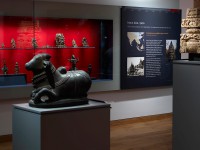Room 32 | India 600-1900 gallery
Explore Hindu, Buddhist and Jain art from India, the Himalayas and Southeast Asia.

Between AD 750 and 1150, Eastern India (Bihar, Bengal and Bangladesh) was mainly ruled by the Pala and Sena dynasties. Buddhism and Hinduism - particularly the growing cult of Vishnu - both continued to flourish in the region.
Bihar owes its name to the many Buddhist monasteries (viharas) that once existed there. Great monastic universities such as Nalanda were major centres of Buddhist teaching and art, visited by monks and scholars from all over Asia. These last strongholds of Indian Buddhism were destroyed by Muslim invaders around 1200.
The sensuous abstractions of the earlier Gupta tradition were reinterpreted in Eastern India in refined bronze images and crisply carved and detailed stone sculptures. The growth of Tantric Buddhist and Hindu cults led to the development of complex new forms of the deities, some benign and others awesome in appearance.
Buddhist sculpture from Eastern India
 Seated figure of Vajrasattva (EA2013.132)
Seated figure of Vajrasattva (EA2013.132)
 Seated figure of Tara (EA2013.76)
Seated figure of Tara (EA2013.76)
 Seated figure of the Buddha (EA2013.93)
Seated figure of the Buddha (EA2013.93)
 Seated figure of Manjushri (EA2013.74)
Seated figure of Manjushri (EA2013.74)
 Female attendant figure (EA2013.94)
Female attendant figure (EA2013.94)
 Figure of Samvara and Vajravarahi (EA2013.77)
Figure of Samvara and Vajravarahi (EA2013.77)
 Seated figure of the goddess Vasudhara (EA1994.50)
Seated figure of the goddess Vasudhara (EA1994.50)
 Stone model of the Mahabodhi temple (EA1996.4)
Stone model of the Mahabodhi temple (EA1996.4)
 Figure of Yamantaka dancing on a buffalo (EA2013.75)
Figure of Yamantaka dancing on a buffalo (EA2013.75)
 Figure of a Buddhist deity (EA1997.253)
Figure of a Buddhist deity (EA1997.253)
 Votive plaque of the Buddha in the Mahabodhi temple (EAX.2354)
Votive plaque of the Buddha in the Mahabodhi temple (EAX.2354)
 Votive plaque of Padmapani (EAX.2340)
Votive plaque of Padmapani (EAX.2340)
 Figure of the Crowned Buddha (EA1965.160)
Figure of the Crowned Buddha (EA1965.160)
 Votive plaque of Vadiraja (EAX.2076)
Votive plaque of Vadiraja (EAX.2076)
 Votive plaque of the Buddha (EAX.2071)
Votive plaque of the Buddha (EAX.2071)
Eastern India: Hindu and Jain sculpture
 Figure of Nandi, the bull of Shiva (EA2013.51)
Figure of Nandi, the bull of Shiva (EA2013.51)
 Figure of Sadashiva, the Eternal Shiva (EA1993.380)
Figure of Sadashiva, the Eternal Shiva (EA1993.380)
 Figure of eight-armed Durga (EA2013.124)
Figure of eight-armed Durga (EA2013.124)
 Figure of Devi dancing in a ring of fire (EA2013.70)
Figure of Devi dancing in a ring of fire (EA2013.70)
 Figure of Siddha (EAOS.104)
Figure of Siddha (EAOS.104)
 Figure of Indra, god of rain, storms, and war (EA1998.29)
Figure of Indra, god of rain, storms, and war (EA1998.29)
 Figure of Agni, god of fire (EA1998.30)
Figure of Agni, god of fire (EA1998.30)
 Figure of Ganesha (EA1980.64)
Figure of Ganesha (EA1980.64)
 Dancing figure of Balakrishna (EA2013.53)
Dancing figure of Balakrishna (EA2013.53)
 Figure of Rishabhanatha with attendants (EA2013.50)
Figure of Rishabhanatha with attendants (EA2013.50)
 Seated figure of Rishabhanatha, the first Tirthankara (EA1998.15)
Seated figure of Rishabhanatha, the first Tirthankara (EA1998.15)
 Figure of Ganesha (EAX.182)
Figure of Ganesha (EAX.182)
 Stele with figure of Shiva (EA1997.181)
Stele with figure of Shiva (EA1997.181)
 Standing figure of Bhairava (EA2013.72)
Standing figure of Bhairava (EA2013.72)
 Stone relief of Shiva (EA2000.26)
Stone relief of Shiva (EA2000.26)
Freestanding sculpture
Notice
Objects may have since been removed or replaced from a gallery. Click into an individual object record to confirm whether or not an object is currently on display. Our object location data is usually updated on a monthly basis, so contact the Jameel Study Centre if you are planning to visit the museum to see a particular Eastern Art object.
© 2013 University of Oxford - Ashmolean Museum









